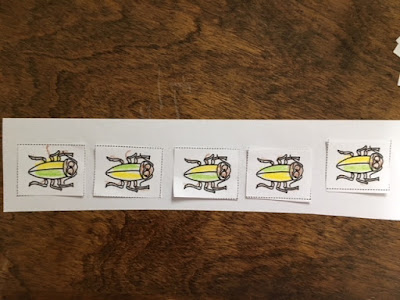Hi All!
Spring is coming. It's warming up and I am spotting bugs and lizards out and about. You can capitalize on kids' interest in insects by doing this pattern activity.
Helping kids look for, notice, and describe patterns is a really important foundational skill in math, particularly to help build a foundation for algebraic thinking. I like to begin by having students build physical patterns with different color and shape pattern blocks. Colored unifix or multilink cubes are great as well. Once students have had experience building physical patterns then you can move to doing some pictorial patterns. The activity below is good for this stage as it allows for a lot of differentiation and it gives them a chance to color, which kids love (and adults too judging from the sales of those adult coloring books!)
1. Give each student a copy of the Insect Parade, crayons or colored pencils, scissors, glue, and a sheet of white copy paper or colored construction paper. Here's a link to this paper: https://drive.google.com/file/d/12qVBHTn8XEP08DUSYfOSeV90Oj4dZbfQ/view?usp=sharing
2. Have them choose a distinct color for each insect on the page and color all of the pictures of that insect that color. For example, there are 5 grasshoppers pictured. Students should color all 5 green. All 5 ladybugs should be red. And so on.
3. Once these insects are colored in, have students cut them out on the dotted lines.
4. Now explain to students that they should arrange 6- 8 insects in a line and "put them on parade" - A Pattern Parade. The insect parade should form a pattern. The student should be able to describe the pattern and why it is a pattern. Here's an example:
5. Once they have created a satisfactory pattern have them glue the insects down and compare pattern parades with another student. They should try to guess each other's patterns.
6. Patterns can be increasingly complex as students are able. This can best be done by doing some intricate coloring on the various parts of the insects as seen below. It can also be done by positioning (such as insects facing forward or backward.)
7. These make a great bulletin board display when completed.
Best,
Bob
PS - This is a variation on a lesson I wrote some time ago in Meeting the Math Standards with Favorite Picture Books (Scholastic, 2002).




Comments
Post a Comment